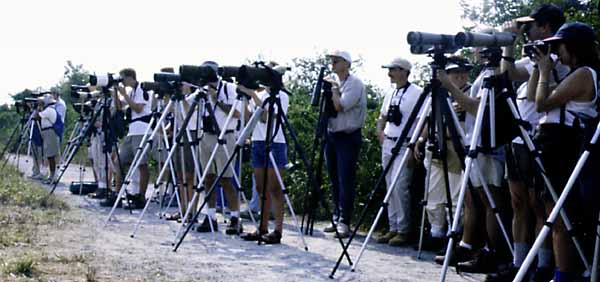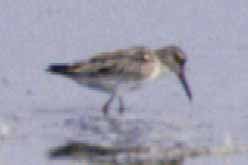|
Just a bit of fun! Although I was able to take extensive
notes, the bird was a little too far for useful pictures. Others
were able to get closer during the subsequent week and managed
to get more convincing pictures. For example, check out Steve Walter's
excellent video grabs.

A few birders enjoying the immature Broad-billed
Sandpiper (Limicola falcinellus) that visited
Jamaica Bay National Wildlife Refuge, Queens, New York at the
end of August 1998.
|

The bird on the far left is the Broad-billed
Sandpiper while the two other peeps are Semi-palmated Sandpipers.
The longer bill and more elongated body shape are clearly
visible. In life, the bird appeared more black and white
than these pictures suggest.
|
|

Dreadful zoom-in showing very little indeed!
|
Here is a brief description of this first record for New York
State:
Broad-billed Sandpiper, Limicola
falcinellus
Jamaica Bay National Wildlife Refuge
Saturday 29th August 1998
Notes by Angus Wilson
Circumstances Bill Benner
reported seeing a possible Broad-billed Sandpiper from the north-eastern
end of the East Pond at Jamaica Bay Refuge (hereafter JBNWR) on
Thursday 27th August 1998. Bill and others discovered the bird
again on Friday afternoon, this time on the West Pond and were
able to confirm his original identification as a Broad-billed Sandpiper
Limicola falcinellus. A truly outstanding discovery!
On Saturday morning (8/29/98), a large number of local birders
assembled at the refuge and spread out to search the scattered
shorebird flock for the bird. At ~9:40 a.m., after checking the
shorebirds gathered on the south shore of the west pond, we (Angus
Wilson, Andy Guthrie, Doug Futuyma, Gail Benson and Tom Burke)
began to make our way to the north end of the East Pond. As we
left the refuge parking lot, we heard from John Fritz (via 2-way
radio) that the bird had been relocated by Sy Schiff and Seth Ausubel
on the north side of the West Pond. We rushed (or to be exact,
ran) to spot where a small crowd including Bob Kurtz and Andy Baldelli
had already assembled. We watched the sandpiper through telescopes
for approximately 1.5 hr. Satisfied, we then checked the shorebirds
on the East Pond for several hours, before returning to study the
bird again on the same stretch of shoreline but in better light.
Detailed description [Adapted
from notes and sketches prepared in the field with the bird in
view. Published material had been reviewed the night before and
some of the more subtle specific details were purposefully sought
out.]
Shape and structure Small
calidrid sandpiper. Slightly larger than a (female?) Western Sandpiper
that was often in the same field of view. Longer body due to greater
primary length. Clearly smaller than White-rumped Sandpiper, three
of which were also in view at times. Short-legged appearance contrasting
with elongated body due to long primaries. Tail generally held
higher than head as it picked along mud (hence giving a slightly
hunched appearance).
Head Pattern Broad white supercilium,
with thinner lateral crown stripe. The two stripes emerged from
a pale area at the base of the bill and almost met again at the
back of the head. The head pattern appeared symmetrical. The supercilia
were prevented from meeting above the bill by a solid dark strip
running from the upper base of the bill onto the crown. Ear coverts
smudged dark. Dark eye line running through lore to base of bill.
Throat dull gray and relatively unmarked.
Breast Pattern Weak collar
formed by diffuse spotting sometimes running into weak streaks.
Flanks Six or more diffuse
brown spots visible on flanks below folded wing. Faint thin flecks
on flanks below primaries. Buff wash to flank at base of folded
wing.
Back Feathering Mantle feathers
solid dark centers with gray fringes.
Tertials Slight buff tone
to edges of pale fringes of tertials.
Primaries Dark (black) with
narrow white edging. When folded, projected beyond tail. Also at
least 5 primaries were visible beyond tertials (thus long primary
projection).
Marginal Coverts Dark with
very little pale edging. Thus formed a dark (black) patch at leading
edge of folded wing. Reminiscent of Sanderling.
Underwing Seen very briefly
a couple of times as the bird landed after flying and once when
it raised its wing to stretch. Clean white matching belly by separated
by buffy flank patch.
Upperwing Rarely seen well.
Seen during short flights, the wings appeared noticeably long and
dark in comparison to accompanying Semi-palmed Sandpipers. Strong
white wing bar.
Tail Rarely seen well. Broad
dark bar running down center of white rump patch (i.e.upper tail
coverts).
Bare Parts Legs appeared dull
or dark gray, sometimes with a lighter brownish cast. Bill slightly
longer than Western Sandpiper, essentially straight until drooping
noticeably for the last 25% of its length. Bill less deep at tip.
Thus resembling Dunlin. When viewed head on, the proximal half
of the bill appeared to broaden compared to the more distal half.
Bill dark black except for a paler (dull green?) wedge on the lower
mandible extending from just beyond the facial feathers to ~1/3
length of bill.
Call Heard to call three times
(whilst watching through telescope). Single rolling pprrrrtt note.
Behavior Fed through most
of the two observation sessions, pausing to roost briefly at a
round 4-4:15 p.m. Mostly fed by picking at surface of wet mud but
occasionally adopted a probing technique resembling Dunlin. Relatively
aggressive maintaining a well-defined feeding territory on the
wet mud of the shoreline. Would displace Semi-palmated Sandpipers
that approached too close. Typically raised it head, stretching
is neck and spreading crown feathers before lunging at the trespasser.
Sometimes became nervous. Not clear if this was in response to
the sometimes noisy crowd of excited birders or other perceived
threats. When flushed returned swiftly to its feeding territory
and resumed picking over surface.
Alternatively, check out Bill Benner's own accounts of his terrific
discovery:
Benner, W. (1998) Broad-billed Sandpiper: First record for Lower
48 States. Kingbird 48: 182-185.
Benner, W. L. (1999) Broad-billed Sandpiper - Jamaica Bay, New
York. Field Notes 52(4): 513-516.
Return
to Gallery Index
|

